FORT ANNNEW YORK |
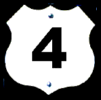 |
| US4 | NY5 | US7 | US9W | US20 | US60 | US202 | US221 | Canal |
FORT ANNNEW YORK |
 |
 |
Fort Ann Fort Ann is the gateway to the north. Here stood five forts, 1690-1777 on the route between Lake Champlain and the Hudson River. |
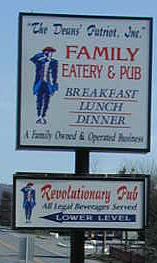 When
you arrive in Fort Ann, you'll see a blockhouse on the left that is actually a
commercial bank.
When
you arrive in Fort Ann, you'll see a blockhouse on the left that is actually a
commercial bank.
Just past the blockhouse, on the right, is a street with a “gateway to the north” marker and an “old well” marker near the Patriot Restaurant. You should turn onto this street, as US Route 4 is a very busy road through Fort Ann.
Fort Ann is still a gateway to the north. Vermont is served by interstates from the south and east, but not the west. Consequently, Fort Ann is on a major truck route between Vermont and Interstates 87 and 90 to the west.
Not far from the gateway marker is a marker for the old well
that was once part of the fort at Fort Ann. The well can be seen between the
restaurant and the fire station.
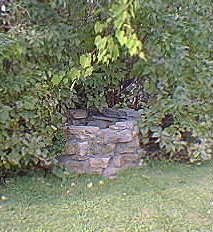 |
Old Well Old well used in fort site built before the revolutionary war by Queen Ann of England. |
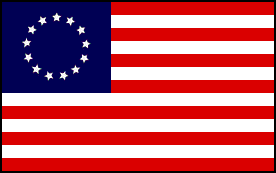 When
advance units of the British forces began moving south in 1777, they encountered
significant resistance from about 550 Americans at Fort Ann on July 8th.
Although no attempt was actually made to permanently hold the position, there
was a two-hour skirmish fought here until it was believed that the advance units
were being reinforced. During the skirmish, the British recorded the capture of
an American flag with thirteen red and white stripes and a constellation. It is
likely that this was the first time the stars and stripes flew in battle.
When
advance units of the British forces began moving south in 1777, they encountered
significant resistance from about 550 Americans at Fort Ann on July 8th.
Although no attempt was actually made to permanently hold the position, there
was a two-hour skirmish fought here until it was believed that the advance units
were being reinforced. During the skirmish, the British recorded the capture of
an American flag with thirteen red and white stripes and a constellation. It is
likely that this was the first time the stars and stripes flew in battle.
After going past the old well and turning left on Catherine Street, you can return back to US Route 4 by turning left at the busy intersection with Route 149 and right at the light. Just past the light on the left is the local library, also a great source for Fort Ann history.
As you depart Fort Ann, there's another question to ponder. Why are there no markers in Fort Ann about the flag?
Enroute to Old Fort Edward
Kingsbury Marker.
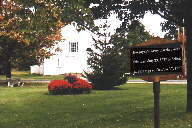 |
Burgoyne's Army marched over this trail, July 29, 1777 to defeat at Saratoga on October 17, 1777. |
Intersection with Burgoyne Avenue. Glens Falls, which is about 3 miles to the west, is on the Hudson River but the shallows, rapids and water falls make the river too difficult for water travel. In the 1700's, Glens Falls was on the carrying route (portage) between the Hudson River and Lake George. US Route 4 parallels the carrying route between the Hudson River and Lake Champlain, although the Lake George route also connects to Lake Champlain at Ticonderoga. In 1777, Burgoyne used both of these routes. The troops went to Fort Edward through Whitehall and Fort Anne. Since his cannons and supplies were still back at Fort Ticonderoga, he had them sent by way of Lake George. Some believe that he did this because he knew the Americans were somewhere to his east and, this way, he could better protect his supply line.
Hudson Falls.
|
|
This memorial cannon is dedicated to the soldiers who fought and died in the area during the Revolutionary War. |
Grave of Jane McCrea. Jane McCrea's grave marker is hard to read. This is what is decipherable:
|
|
Here rests the remains of Jane McCrea, aged 17, made captive and murdered by a band of Indians, while on a visit to a relative in this neighborhood, AD 1777. To commemorate one of the most thrilling incidents in the annals of the American Revolution to do justice to the fame of the . . . British Officer to whom she was . . . and as simple tribute to the memory of the departed, this stone was erected by her niece, Sara Hanna Payne, A.D. 1852. |
Probably, the worst fear of any military officer is the accidental killing of innocent civilians that inevitably get caught in the middle of battle. Burgoyne employed Native American Indians in his army, primarily in scouting missions ahead of his main army. The problem was their custom of taking scalps, something that Burgoyne seemed to reluctantly accept in return for their loyalty and cooperation.
 Jane
McCrea, a young, beautiful girl with long black hair was betrothed to one of
Burgoyne's officers. Tragically, she became a civilian caught in the middle of a
skirmish between Indians near Fort Edward. She was killed and her scalp was
taken. The scalp was recognized immediately by the anguished officer and he
demanded that Burgoyne punish the Indian by death. Out of fear of causing a mass
desertion of all the Indians, Burgoyne left the punishment to the Indian chief,
which meant practically no punishment at all.
Jane
McCrea, a young, beautiful girl with long black hair was betrothed to one of
Burgoyne's officers. Tragically, she became a civilian caught in the middle of a
skirmish between Indians near Fort Edward. She was killed and her scalp was
taken. The scalp was recognized immediately by the anguished officer and he
demanded that Burgoyne punish the Indian by death. Out of fear of causing a mass
desertion of all the Indians, Burgoyne left the punishment to the Indian chief,
which meant practically no punishment at all.
The story of Jane McCrea traveled quickly. It soon became a rallying cry for Americans and helped to swell the ranks forming for the Battles of Saratoga. In England, it fed the fire of those who were against the war and contributed greatly to its growing unpopularity.
